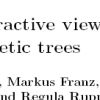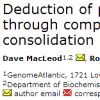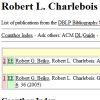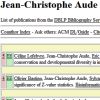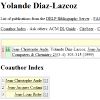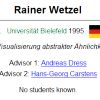| |
  
Steven Kelk,
Celine Scornavacca and
Leo van Iersel. On the elusiveness of clusters. In TCBB, Vol. 9(2):517-534, 2012.
Keywords: explicit network, from clusters, from rooted trees, from triplets, level k phylogenetic network, phylogenetic network, phylogeny, Program Clustistic, reconstruction, software.
Note: http://arxiv.org/abs/1103.1834.
|
|
| |
 
Paul Phipps and
Sergey Bereg. Optimizing Phylogenetic Networks for Circular Split Systems. In TCBB, Vol. 9(2):535-547, 2012.
Keywords: abstract network, from distances, from splits, phylogenetic network, phylogeny, Program PhippsNetwork, reconstruction, software.
Toggle abstract
"We address the problem of realizing a given distance matrix by a planar phylogenetic network with a minimum number of faces. With the help of the popular software SplitsTree4, we start by approximating the distance matrix with a distance metric that is a linear combination of circular splits. The main results of this paper are the necessary and sufficient conditions for the existence of a network with a single face. We show how such a network can be constructed, and we present a heuristic for constructing a network with few faces using the first algorithm as the base case. Experimental results on biological data show that this heuristic algorithm can produce phylogenetic networks with far fewer faces than the ones computed by SplitsTree4, without affecting the approximation of the distance matrix. © 2012 IEEE."
|
|
| |
 
Zhi-Zhong Chen and
Lusheng Wang. Algorithms for Reticulate Networks of Multiple Phylogenetic Trees. In TCBB, Vol. 9(2):372-384, 2012.
Keywords: explicit network, from rooted trees, minimum number, phylogenetic network, phylogeny, Program CMPT, Program MaafB, reconstruction, software.
Note: http://rnc.r.dendai.ac.jp/~chen/papers/rMaaf.pdf.
Toggle abstract
"A reticulate network N of multiple phylogenetic trees may have nodes with two or more parents (called reticulation nodes). There are two ways to define the reticulation number of N. One way is to define it as the number of reticulation nodes in N in this case, a reticulate network with the smallest reticulation number is called an optimal type-I reticulate network of the trees. The better way is to define it as the total number of parents of reticulation nodes in N minus the number of reticulation nodes in N ; in this case, a reticulate network with the smallest reticulation number is called an optimal type-II reticulate network of the trees. In this paper, we first present a fast fixed-parameter algorithm for constructing one or all optimal type-I reticulate networks of multiple phylogenetic trees. We then use the algorithm together with other ideas to obtain an algorithm for estimating a lower bound on the reticulation number of an optimal type-II reticulate network of the input trees. To our knowledge, these are the first fixed-parameter algorithms for the problems. We have implemented the algorithms in ANSI C, obtaining programs CMPT and MaafB. Our experimental data show that CMPT can construct optimal type-I reticulate networks rapidly and MaafB can compute better lower bounds for optimal type-II reticulate networks within shorter time than the previously best program PIRN designed by Wu. © 2006 IEEE."
|
|
| |
    
Changiz Eslahchi,
Reza Hassanzadeh,
Ehsan Mottaghi,
Mahnaz Habibi,
Hamid Pezeshk and
Mehdi Sadeghi. Constructing circular phylogenetic networks from weighted quartets using simulated annealing. In MBIO, Vol. 235(2):123-127, 2012.
Keywords: abstract network, from quartets, heuristic, phylogenetic network, phylogeny, Program SAQ-Net, Program SplitsTree, reconstruction, simulated annealing, software, split network.
Note: http://dx.doi.org/10.1016/j.mbs.2011.11.003.
Toggle abstract
"In this paper, we present a heuristic algorithm based on the simulated annealing, SAQ-Net, as a method for constructing phylogenetic networks from weighted quartets. Similar to QNet algorithm, SAQ-Net constructs a collection of circular weighted splits of the taxa set. This collection is represented by a split network. In order to show that SAQ-Net performs better than QNet, we apply these algorithm to both the simulated and actual data sets containing salmonella, Bees, Primates and Rubber data sets. Then we draw phylogenetic networks corresponding to outputs of these algorithms using SplitsTree4 and compare the results. We find that SAQ-Net produces a better circular ordering and phylogenetic networks than QNet in most cases. SAQ-Net has been implemented in Matlab and is available for download at http://bioinf.cs.ipm.ac.ir/softwares/saq.net. © 2011 Elsevier Inc."
|
|
| |
 
Hyun Jung Park and
Luay Nakhleh. MURPAR: A fast heuristic for inferring parsimonious phylogenetic networks from multiple gene trees. In ISBRA12, Vol. 7292:213-224 of LNCS, springer, 2012.
Keywords: explicit network, from unrooted trees, heuristic, phylogenetic network, phylogeny, reconstruction, software.
Note: https://www.researchgate.net/profile/Hyun_Jung_Park2/publication/262318595_MURPAR_A_Fast_Heuristic_for_Inferring_Parsimonious_Phylogenetic_Networks_from_Multiple_Gene_Trees/links/54b7e7b50cf269d8cbf58cc4.pdf.
Toggle abstract
"Phylogenetic networks provide a graphical representation of evolutionary histories that involve non-treelike evolutionary events, such as horizontal gene transfer (HGT). One approach for inferring phylogenetic networks is based on reconciling gene trees, assuming all incongruence among the gene trees is due to HGT. Several mathematical results and algorithms, both exact and heuristic, have been introduced to construct and analyze phylogenetic networks. Here, we address the computational problem of inferring phylogenetic networks with minimum reticulations from a collection of gene trees. As this problem is known to be NP-hard even for a pair of gene trees, the problem at hand is very hard. In this paper, we present an efficient heuristic, MURPAR, for inferring a phylogenetic network from a collection of gene trees by using pairwise reconciliations of trees in the collection. Given the development of efficient and accurate methods for pairwise gene tree reconciliations, MURPAR inherits this efficiency and accuracy. Further, the method includes a formulation for combining pairwise reconciliations that is naturally amenable to an efficient integer linear programming (ILP) solution. We show that MURPAR produces more accurate results than other methods and is at least as fast, when run on synthetic and biological data. We believe that our method is especially important for rapidly obtaining estimates of genome-scale evolutionary histories that can be further refined by more detailed and compute-intensive methods. © 2012 Springer-Verlag."
|
|
| |
  
Reza Hassanzadeh,
Changiz Eslahchi and
Wing-Kin Sung. Constructing phylogenetic supernetworks based on simulated annealing. In MPE, Vol. 63(3):738-744, 2012.
Keywords: abstract network, from unrooted trees, heuristic, phylogenetic network, phylogeny, Program SNSA, reconstruction, simulated annealing, software, split network.
Note: http://dx.doi.org/10.1016/j.ympev.2012.02.009.
Toggle abstract
Different partial phylogenetic trees can be derived from different sources of evidence and different methods. One important problem is to summarize these partial phylogenetic trees using a supernetwork. We propose a novel simulated annealing based method called SNSA which uses an optimization function to produce a simple network that still retains a great deal of phylogenetic information. We report the performance of this new method on real and simulated datasets. © 2012 Elsevier Inc.
|
|
| |
   
Leo van Iersel,
Steven Kelk,
Nela Lekic and
Celine Scornavacca. A practical approximation algorithm for solving massive instances of hybridization number. In WABI12, Vol. 7534(430-440) of LNCS, springer, 2012.
Keywords: agreement forest, approximation, explicit network, from rooted trees, hybridization, phylogenetic network, phylogeny, Program CycleKiller, Program Dendroscope, Program HybridNET, reconstruction, software.
Note: http://arxiv.org/abs/1205.3417.
Toggle abstract
"Reticulate events play an important role in determining evolutionary relationships. The problem of computing the minimum number of such events to explain discordance between two phylogenetic trees is a hard computational problem. In practice, exact solvers struggle to solve instances with reticulation number larger than 40. For such instances, one has to resort to heuristics and approximation algorithms. Here we present the algorithm CycleKiller which is the first approximation algorithm that can produce solutions verifiably close to optimality for instances with hundreds or even thousands of reticulations. Theoretically, the algorithm is an exponential-time 2-approximation (or 4-approximation in its fastest mode). However, using simulations we demonstrate that in practice the algorithm runs quickly for large and difficult instances, producing solutions within one percent of optimality. An implementation of this algorithm, which extends the theoretical work of [14], has been made publicly available. © 2012 Springer-Verlag."
|
|
| |
  
Alix Boc,
Alpha B. Diallo and
Vladimir Makarenkov. T-REX: a web server for inferring, validating and visualizing phylogenetic trees and networks. In NAR, Vol. 40(W1):W573-W579, 2012.
Keywords: from rooted trees, from species tree, lateral gene transfer, phylogenetic network, phylogeny, Program T REX, reconstruction, reticulogram, software.
Note: http://dx.doi.org/10.1093/nar/gks485.
Toggle abstract
"T-REX (Tree and reticulogram REConstruction) is a web server dedicated to the reconstruction of phylogenetic trees, reticulation networks and to the inference of horizontal gene transfer (HGT) events. T-REX includes several popular bioinformatics applications such as MUSCLE, MAFFT, Neighbor Joining, NINJA, BioNJ, PhyML, RAxML, random phylogenetic tree generator and some well-known sequence-to-distance transformation models. It also comprises fast and effective methods for inferring phylogenetic trees from complete and incomplete distance matrices as well as for reconstructing reticulograms and HGT networks, including the detection and validation of complete and partial gene transfers, inference of consensus HGT scenarios and interactive HGT identification, developed by the authors. The included methods allows for validating and visualizing phylogenetic trees and networks which can be built from distance or sequence data. The web server is available at: www.trex.uqam.ca. © 2012 The Author(s)."
|
|
| |
 
Daniel H. Huson and
Celine Scornavacca. Dendroscope 3: An Interactive Tool for Rooted Phylogenetic Trees and Networks. In Systematic Biology, Vol. 61(6):1061-1067, 2012.
Keywords: from rooted trees, from triplets, phylogenetic network, phylogeny, Program Dendroscope, reconstruction, software, visualization.
Toggle abstract
"Dendroscope 3 is a new program for working with rooted phylogenetic trees and networks. It provides a number of methods for drawing and comparing rooted phylogenetic networks, and for computing them from rooted trees. The program can be used interactively or in command-line mode. The program is written in Java, use of the software is free, and installers for all 3 major operating systems can be downloaded from www.dendroscope.org. [Phylogenetic trees; phylogenetic networks; software.] © 2012 The Author(s)."
|
|
| |
 
Zhi-Zhong Chen,
Lusheng Wang and
Satoshi Yamanaka. A fast tool for minimum hybridization networks. In BMCB, Vol. 13:155, 2012.
Keywords: agreement forest, explicit network, from rooted trees, phylogenetic network, phylogeny, Program FastHN, reconstruction, software.
Note: http://dx.doi.org/10.1186/1471-2105-13-155.
Toggle abstract
"Background: Due to hybridization events in evolution, studying two different genes of a set of species may yield two related but different phylogenetic trees for the set of species. In this case, we want to combine the two phylogenetic trees into a hybridization network with the fewest hybridization events. This leads to three computational problems, namely, the problem of computing the minimum size of a hybridization network, the problem of constructing one minimum hybridization network, and the problem of enumerating a representative set of minimum hybridization networks. The previously best software tools for these problems (namely, Chen and Wang's HybridNet and Albrecht et al.'s Dendroscope 3) run very slowly for large instances that cannot be reduced to relatively small instances. Indeed, when the minimum size of a hybridization network of two given trees is larger than 23 and the problem for the trees cannot be reduced to relatively smaller independent subproblems, then HybridNet almost always takes longer than 1 day and Dendroscope 3 often fails to complete. Thus, a faster software tool for the problems is in need.Results: We develop a software tool in ANSI C, named FastHN, for the following problems: Computing the minimum size of a hybridization network, constructing one minimum hybridization network, and enumerating a representative set of minimum hybridization networks. We obtain FastHN by refining HybridNet with three ideas. The first idea is to preprocess the input trees so that the trees become smaller or the problem becomes to solve two or more relatively smaller independent subproblems. The second idea is to use a fast algorithm for computing the rSPR distance of two given phylognetic trees to cut more branches of the search tree in the exhaustive-search stage of the algorithm. The third idea is that during the exhaustive-search stage of the algorithm, we find two sibling leaves in one of the two forests (obtained from the given trees by cutting some edges) such that they are as far as possible in the other forest. As the result, FastHN always runs much faster than HybridNet. Unlike Dendroscope 3, FastHN is a single-threaded program. Despite this disadvantage, our experimental data shows that FastHN runs substantially faster than the multi-threaded Dendroscope 3 on a PC with multiple cores. Indeed, FastHN can finish within 16 minutes (on average on a Windows-7 (x64) desktop PC with i7-2600 CPU) even if the minimum size of a hybridization network of two given trees is about 25, the trees each have 100 leaves, and the problem for the input trees cannot be reduced to two or more independent subproblems via cluster reductions. It is also worth mentioning that like HybridNet, FastHN does not use much memory (indeed, the amount of memory is at most quadratic in the input size). In contrast, Dendroscope 3 uses a huge amount of memory. Executables of FastHN for Windows XP (x86), Windows 7 (x64), Linux, and Mac OS are available (see the Results and discussion section for details).Conclusions: For both biological datasets and simulated datasets, our experimental results show that FastHN runs substantially faster than HybridNet and Dendroscope 3. The superiority of FastHN in speed over the previous tools becomes more significant as the hybridization number becomes larger. In addition, FastHN uses much less memory than Dendroscope 3 and uses the same amount of memory as HybridNet. © 2012 Chen et al.; licensee BioMed Central Ltd."
|
|
| |
|
| |
  
Fenglou Mao,
David Williams,
Olga Zhaxybayeva,
Maria S. Poptsova,
Pascal Lapierre,
J. Peter Gogarten and
Ying Xu. Quartet decomposition server: a platform for analyzing phylogenetic trees. In BMCB, Vol. 13:123, 2012.
Keywords: abstract network, from quartets, phylogenetic network, phylogeny, Program Quartet Decomposition, reconstruction, software, split network.
Toggle abstract
"Background: The frequent exchange of genetic material among prokaryotes means that extracting a majority or plurality phylogenetic signal from many gene families, and the identification of gene families that are in significant conflict with the plurality signal is a frequent task in comparative genomics, and especially in phylogenomic analyses. Decomposition of gene trees into embedded quartets (unrooted trees each with four taxa) is a convenient and statistically powerful technique to address this challenging problem. This approach was shown to be useful in several studies of completely sequenced microbial genomes.Results: We present here a web server that takes a collection of gene phylogenies, decomposes them into quartets, generates a Quartet Spectrum, and draws a split network. Users are also provided with various data download options for further analyses. Each gene phylogeny is to be represented by an assessment of phylogenetic information content, such as sets of trees reconstructed from bootstrap replicates or sampled from a posterior distribution. The Quartet Decomposition server is accessible at http://quartets.uga.edu.Conclusions: The Quartet Decomposition server presented here provides a convenient means to perform Quartet Decomposition analyses and will empower users to find statistically supported phylogenetic conflicts. © 2012 Mao et al.; licensee BioMed Central Ltd."
|
|
|
 - forked on GitHub.
- forked on GitHub.































































































